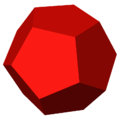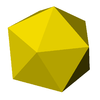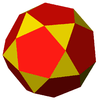Zonohedron
A zonohedron is a convex polyhedron where every face is a polygon with point symmetry or, equivalently, symmetry under rotations through 180°. Any zonohedron may equivalently be described as the Minkowski sum of a set of line segments in three-dimensional space, or as the three-dimensional projection of a hypercube. Zonohedra were originally defined and studied by E. S. Fedorov, a Russian crystallographer. More generally, in any dimension, the Minkowski sum of line segments forms a polytope known as a zonotope.
Zonohedra that tile space
The original motivation for studying zonohedra is that the Voronoi diagram of any lattice forms a convex uniform honeycomb in which the cells are zonohedra. Any zonohedron formed in this way can tessellate 3-dimensional space and is called a primary parallelohedron. Each primary parallelohedron is combinatorially equivalent to one of five types: the rhombohedron (including the cube), hexagonal prism, truncated octahedron, rhombic dodecahedron, and the rhombo-hexagonal dodecahedron.
Zonohedra from Minkowski sums
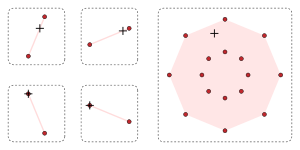
Let {v0, v1, ...} be a collection of three-dimensional vectors. With each vector vi we may associate a line segment {xivi|0≤xi≤1}. The Minkowski sum {Σxivi|0≤xi≤1} forms a zonohedron, and all zonohedra that contain the origin have this form. The vectors from which the zonohedron is formed are called its generators. This characterization allows the definition of zonohedra to be generalized to higher dimensions, giving zonotopes.
Each edge in a zonohedron is parallel to at least one of the generators, and has length equal to the sum of the lengths of the generators to which it is parallel. Therefore, by choosing a set of generators with no parallel pairs of vectors, and by setting all vector lengths equal, we may form an equilateral version of any combinatorial type of zonohedron.
By choosing sets of vectors with high degrees of symmetry, we can form in this way, zonohedra with at least as much symmetry. For instance, generators equally spaced around the equator of a sphere, together with another pair of generators through the poles of the sphere, form zonohedra in the form of prism over regular 2k-gons: the cube, hexagonal prism, octagonal prism, decagonal prism, dodecagonal prism, etc. Generators parallel to the edges of an octahedron form a truncated octahedron, and generators parallel to the long diagonals of a cube form a rhombic dodecahedron.
The Minkowski sum of any two zonohedra is another zonohedron, generated by the union of the generators of the two given zonohedra. Thus, the Minkowski sum of a cube and a truncated octahedron forms the truncated cuboctahedron, while the Minkowski sum of the cube and the rhombic dodecahedron forms the truncated rhombic dodecahedron. Both of these zonohedra are simple (three faces meet at each vertex), as is the truncated small rhombicuboctahedron formed from the Minkowski sum of the cube, truncated octahedron, and rhombic dodecahedron.
Zonohedra from arrangements
The Gauss map of any convex polyhedron maps each face of the polygon to a point on the unit sphere, and maps each edge of the polygon separating a pair of faces to a great circle arc connecting the corresponding two points. In the case of a zonohedron, the edges surrounding each face can be grouped into pairs of parallel edges, and when translated via the Gauss map any such pair becomes a pair of contiguous segments on the same great circle. Thus, the edges of the zonohedron can be grouped into zones of parallel edges, which correspond to the segments of a common great circle on the Gauss map, and the 1-skeleton of the zonohedron can be viewed as the planar dual graph to an arrangement of great circles on the sphere. Conversely any arrangement of great circles may be formed from the Gauss map of a zonohedron generated by vectors perpendicular to the planes through the circles.
Any simple zonohedron corresponds in this way to a simplicial arrangement, one in which each face is a triangle. Simplicial arrangements of great circles correspond via central projection to simplicial arrangements of lines in the projective plane, which were studied by Grünbaum (1972). He listed three infinite families of simplicial arrangements, one of which leads to the prisms when converted to zonohedra, and the other two of which correspond to additional infinite families of simple zonohedra. There are also many known examples that do not fit into these three families.
Types of Zonohedra
Any prism over a regular polygon with an even number of sides forms a zonohedron. These prisms can be formed so that all faces are regular: two opposite faces are equal to the regular polygon from which the prism was formed, and these are connected by a sequence of square faces. Zonohedra of this type are the cube, hexagonal prism, octagonal prism, decagonal prism, dodecagonal prism, etc.
In addition to this infinite family of regular-faced zonohedra, there are three Archimedean solids, all omnitruncations of the regular forms:
- The truncated octahedron, with 6 square and 8 hexagonal faces. (Omnitruncated tetrahedron)
- The truncated cuboctahedron, with 12 squares, 8 hexagons, and 6 octagons. (Omnitruncated cube)
- The truncated icosidodecahedron, with 30 squares, 20 hexagons and 12 decagons. (Omnitruncated dodecahedron)
In addition, certain Catalan solids (duals of Archimedean solids) are again zonohedra:
- The rhombic dodecahedron is the dual of the cuboctahedron.
- The rhombic triacontahedron is the dual of the icosidodecahedron.
Others with all rhombic faces:
| zonohedron | image | number of generators |
regular face | face-transitive | edge-transitive | vertex-transitive | Parallelohedron (space-filling) |
simple |
|---|---|---|---|---|---|---|---|---|
| cube 4.4.4 |
 |
3 | Yes | Yes | Yes | Yes | Yes | Yes |
| hexagonal prism 4.4.6 |
 |
4 | Yes | No | No | Yes | Yes | Yes |
| 2n-prism (n > 3) 4.4.2n |
 |
n + 1 | Yes | No | No | Yes | No | Yes |
| truncated octahedron 4.6.6 |
 |
6 | Yes | No | No | Yes | Yes | Yes |
| Truncated cuboctahedron 4.6.8 |
 |
8 | Yes | No | No | Yes | No | Yes |
| Truncated icosidodecahedron 4.6.10 |
 |
15 | Yes | No | No | Yes | No | Yes |
| rhombic dodecahedron V3.4.3.4 |
 |
4 | No | Yes | Yes | No | Yes | No |
| rhombic triacontahedron V3.5.3.5 |
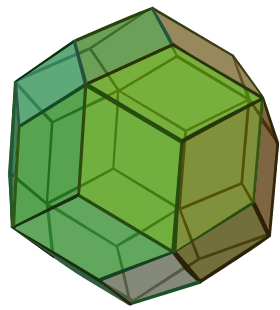 |
6 | No | Yes | Yes | No | No | No |
| rhombo-hexagonal dodecahedron |  |
5 | No | No | No | No | Yes | No |
| truncated rhombic dodecahedron |  |
7 | No | No | No | No | No | Yes |
Dissection of zonohedra
Although it is not generally true that any polyhedron has a dissection into any other polyhedron of the same volume (see Hilbert's third problem), it is known that any two zonohedra of equal volumes can be dissected into each other.
Zonohedrification
Zonohedrification is a process defined by George W. Hart for creating a zonohedron from another polyhehedron.[1][2]
First the vertices of any polyhedron are considered vectors from the polyhedron center. These vectors create the zonohedron which we call the zonohedrification of the original polyhedron. Any two vertices of the original polyhedron, there are two opposite planes of the zonohedrification which each have two edges parallel to the vertex vectors.
Zonotopes
The Minkowski sum of line segments in any dimension forms a type of polytope called a zonotope. The facets of any zonotope are themselves zonotopes of one lower dimension. Examples of four-dimensional zonotopes include the tesseract (Minkowski sums of d mutually perpendicular equal length line segments), the omnitruncated 5-cell, and the truncated 24-cell. Every permutohedron is a zonotope.
References
- ↑ http://www.georgehart.com/virtual-polyhedra/zonohedrification.html
- ↑ Zonohedrification', George W. Hart, The Mathematica Journal, 1999, Volume: 7, Issue: 3, pp. 374-389
- Coxeter, H. S. M (1962). "The Classification of Zonohedra by Means of Projective Diagrams". J. Math. Pures Appl. 41: 137–156. Reprinted in Coxeter, H. S. M (1999). The Beauty of Geometry. Mineola, NY: Dover. pp. 54–74. ISBN 0-486-40919-8.
- Eppstein, David (1996). "Zonohedra and zonotopes". Mathematica in Education and Research. 5 (4): 15–21.
- Grünbaum, Branko (1972). Arrangements and Spreads. Number 10 in Regional Conf. Series in Mathematics, American Mathematical Society.
- Fedorov, E. S. (1893). "Elemente der Gestaltenlehre". Zeitschrift für Krystallographie und Mineralogie. 21: 671–694.
- Rolf Schneider, Chapter 3.5 "Zonoids and other classes of convex bodies" in Convex bodies: the Brunn-Minkowski theory, Cambridge University Press, Cambridge, 1993.
- Shephard, G. C. (1974). "Space-filling zonotopes". Mathematika. 21 (2): 261–269. doi:10.1112/S0025579300008652.
- Taylor, Jean E. (1992). "Zonohedra and generalized zonohedra". American Mathematical Monthly. 99 (2): 108–111. doi:10.2307/2324178. JSTOR 2324178.
External links
- Eppstein, David. "The Geometry Junkyard: Zonohedra and Zonotopes".
- Hart, George W. "Virtual Polyhedra: Zonohedra".
- Weisstein, Eric W. "Primary Parallelohedron". MathWorld.
- Bulatov, Vladimir. "Zonohedral Polyhedra Completion".






